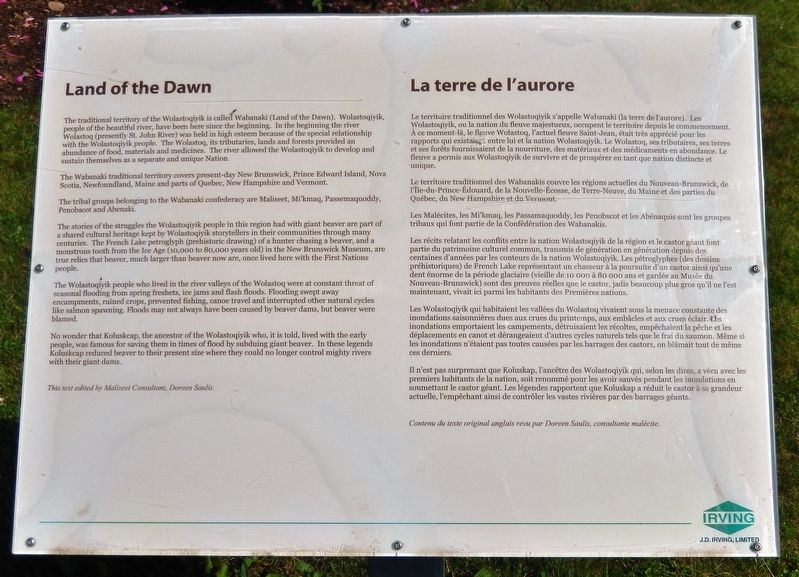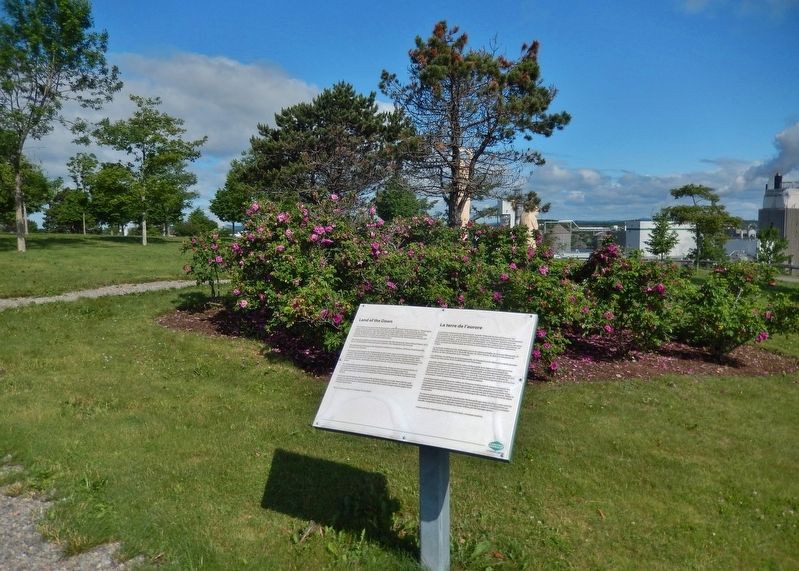Saint John in Saint John County, New Brunswick — The Atlantic Provinces (North America)
Land of the Dawn
La terre de l’aurore
Land of the Dawn
The traditional territory of the Wolastoqiyik is called Wabanaki (Land of the Dawn). Wolastoqiyik, people of the beautiful river, have been here since the beginning. In the beginning the river Wolastoq (presently St. John River) was held in high esteem because of the special relationship with the Wolastoqiyik people. The Wolastoq, its tributaries, lands and forests provided an abundance of food, materials and medicines. The river allowed the Wolastoqiyik to develop and sustain themselves as a separate and unique Nation.
The Wabanaki traditional territory covers present-day New Brunswick, Prince Edward Island, Nova Scotia, Newfoundland, Maine and parts of Quebec, New Hampshire and Vermont.
The tribal groups belonging to the Wabanaki confederacy are Maliseet, Mi’kmaq, Passemaquoddy, Penobscot and Abenaki.
The stories of the struggles the Wolastoqiyik people in this region had with giant beaver are part of a shared cultural heritage kept by Wolastoqiyik storytellers in their communities through many centuries. The French Lake petroglyph (prehistoric drawing) of a hunter chasing a beaver, and a monstrous tooth from the Ice Age (10,000 to 80,000 years old) in the New Brunswick Museum, are true relics that beaver, much larger than beaver now are, once lived here with the First Nations people.
The Wolastoqiyik people who lived in the river valleys of the Wolastoq were at constant threat of seasonal flooding from spring freshets, ice jams and flash floods. Flooding swept away encampments, ruined crops, prevented fishing, canoe travel and interrupted other natural cycles like salmon spawning. Floods may not always have been caused by beaver dams, but beaver were blamed.
No wonder that Koluskcap, the ancestor of the Wolastoqiyik who, it is told, lived with the early people, was famous for saving them in times of flood by subduing giant beaver. In these legends Koluskcap reduced beaver to their present size where they could no longer control mighty rivers with their giant dams.
This text edited by Maliseet Consultant, Doreen Saulis.
La terre de l'aurore
Le territoire traditionnel des Wolastoqiyik s'appelle Wabanaki (la terre de l'aurore). Les Wolastoqiyik, ou la nation du fleuve majestueux, occupent le territoire depuis le commencement. À ce moment-là, le fleuve Wolastoq, l'actuel fleuve Saint-Jean, était très apprécié pour les rapports qui existaient entre lui et la nation Wolastoqiyik. Le Wolastoq, ses tributaires, ses terres et ses forêts fournissaient de la nourriture, des matériaux et des médicaments en abondance. Le fleuve a permis aux Wolastoqiyik de survivre et de prospérer en tant que nation distincte et unique.
Le territoire traditionnel des Wabanakis couvre les régions actuelles du Nouveau-Brunswick, de l'île-du-Prince-Édouard, de la Nouvelle-Écosse, de Terre-Neuve, du Maine et des parties du Québec, du New Hampshire et du Vermont.
Les Malécites, les Mi'kmaq, les Passamaquoddy, les Penobscot et les Abénaquis sont les groupes tribaux qui font partie de la Confédération des Wabanakis.
Les récits relatant les conflits entre la nation Wolastoqiyik de la région et le castor géant font partie du patrimoine culturel commun, transmis de génération en génération depuis des centaines d'années par les conteurs de la nation Wolastoqiyik. Les pétroglyphes (des dessins préhistoriques) de French Lake représentant un chasseur à la poursuite d'un castor ainsi qu'une dent énorme de la période glaciaire (vieille de 10 000 à 80 000 ans et gardée au Musée du Nouveau-Brunswick) sont des preuves réelles que le castor, jadis beaucoup plus gros qu'il ne l'est maintenant, vivait ici parmi les habitants des Premières nations.
Les Wolastoqiyik qui habitaient les vallées du Wolastoq vivaient sous la menace constante des inondations saisonnières dues aux crues du printemps, aux embâcles et aux crues éclair. Les inondations emportaient les campements, détruisaient les récoltes, empêchaient la pêche et les déplacements en canot et dérangeaient d'autres cycles naturels tels que le frai du saumon. Même si les inondations n'étaient pas toutes causées par les barrages des castors, on blâmait tout de même ces derniers.
Il n'est pas surprenant que Koluskap, l'ancêtre des Wolastoqiyik qui, selon les dires, a vécu avec les premiers habitants de la nation, soit renommé pour les avoir sauvés pendant les inondations en soumettant le castor géant. Les légendes rapportent que Koluskap a réduit le castor à sa grandeur actuelle, l'empêchant ainsi de contrôler les vastes rivières par des barrages géants.
Contenu du texte original anglais revu par Doreen Saulis, consultante malécite.
Erected by J.D. Irving, Limited.
Topics. This historical marker is listed in these topic lists: Animals • Native Americans • Waterways & Vessels.
Location. 45° 15.448′ N, 66° 5.356′ W. Marker is in Saint John, New Brunswick, in Saint John County. Marker can be reached from Lancaster Avenue, 0.2 kilometers east of Bridge Road (New Brunswick Route 100), on the left when traveling east. Marker is located along the walking path in Wolastoq Park, near the northeast corner of the park. Touch for map. Marker is at or near this postal address: 211 Lancaster Avenue, Saint John NB E2M 2K8, Canada. Touch for directions.
Other nearby markers. At least 8 other markers are within walking distance of this marker. Koluskap and Beaver (a few steps from this marker); Wolastoq Park (a few steps from this marker); Samuel de Champlain (a few steps from this marker); Françoise Marie Jacquelin (within shouting distance of this marker); Mills at Union Point (within shouting distance of this marker); The New Community of Saint John (within shouting distance of this marker); Rebels Attack (within shouting distance of this marker); Charles Gorman (within shouting distance of this marker). Touch for a list and map of all markers in Saint John.
Related markers. Click here for a list of markers that are related to this marker. Wolastoq Park
Also see . . . Wolastoqiyik (Maliseet). Wolastoqiyik (also Welastekwewiyik or Welustuk), meaning “people of the beautiful river” in their language, have long resided along the Saint John River in New Brunswick and Maine, and the St. Lawrence River in Quebec. Historically, the Europeans referred to the Wolastoqiyik by a Mi’kmaq word, Maliseet (or Malecite), roughly translating to English as “broken talkers.” The name indicates that, according to the Mi’kmaq, the Wolastoqiyik language is a “broken” version of their own. Today, there are six Wolastoqiyik Maritime communities in Canada and one in Maine. In the 2016 census, 7,635 people identified as having Wolastoqiyik ancestry. (Submitted on October 29, 2019, by Cosmos Mariner of Cape Canaveral, Florida.)
Credits. This page was last revised on November 3, 2022. It was originally submitted on October 22, 2019, by Cosmos Mariner of Cape Canaveral, Florida. This page has been viewed 238 times since then and 33 times this year. Photos: 1, 2. submitted on October 29, 2019, by Cosmos Mariner of Cape Canaveral, Florida.

